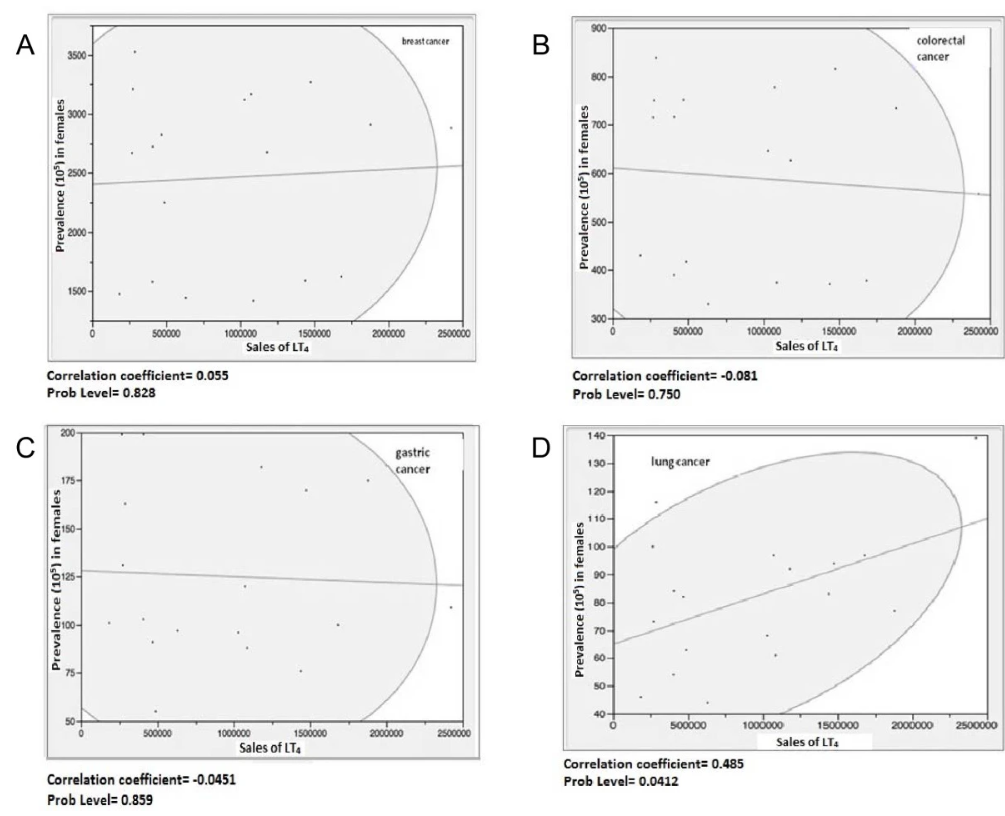
Comment:
While this ecological study is, as detailed in the appraisal, deeply flawed and certainly cannot be used to draw any causal conclusions, it raised a provocative, hypothesis-generating question. Further studies have substantiated that there are links between levothyroxine use and cancer.
The proposed mechanism—oxidative stress—is biologically plausible. We know that thyroid hormones are powerful regulators of metabolism, and it is not a significant leap to suggest that a chronic supraphysiological state, even if iatrogenic, could increase oxidative damage over time.
Summary:
🩺 Clinical Bottom Line
This paper shows a statistical association between higher regional sales of levothyroxine (LT4) and higher regional prevalence of lung cancer in females across Italy. The authors propose this link may be due to oxidative stress caused by LT4 supplementation.
However, this is a very weak, hypothesis-generating study design (an ecological study) that cannot prove causation. The study’s conclusion is based on group-level data (e.g., total sales in a region vs. total cancers in a region), making it impossible to know if the individuals who developed lung cancer were the same ones taking LT4. The authors themselves admit the findings “suffer of many limitations”, and the potential for unmeasured confounding is extremely high. These findings are not applicable to clinical practice and should not be used to counsel patients.
📊 Results in Context
-
Main Results: The study correlated regional LT4 sales from 2009 with regional cancer prevalence in 2010 for females aged 30-84 across 18 Italian regions.
-
No significant correlation was found between LT4 sales and the prevalence of breast cancer, colorectal cancer, or gastric cancer.
-
A statistically significant positive correlation was found for lung cancer (Correlation coefficient = 0.485; p = 0.0412). A p-value of 0.0412 suggests that this observed association is unlikely to be due to random chance alone.
-
Confounder Analysis: The authors report using a “Sequential test” to adjust for smoking and age. After this adjustment, they state the relationship between LT4 and lung cancer remained significant (p = 0.003), while age was not a significant contributor (p = 0.532).
-
Participants: The data was aggregated at the regional level, focusing on females aged 30-84. The average LT4 consumption was estimated at 0.7 boxes per woman per year.
🧐 Assertive Critical Appraisal
-
Limitations & Bias (STROBE Framework): This study has severe methodological flaws that fatally undermine its conclusions.
-
Ecological Fallacy: This is the most critical flaw. The study uses aggregated, regional-level data. It correlates the total sales of LT4 in a region with the total prevalence of lung cancer in that same region. This design makes it impossible to determine if the specific women who developed lung cancer were the ones taking LT4. The association could easily be caused by an unknown third variable (a confounder).
-
Crude Data & Confounding: The authors acknowledge they could not determine LT4 dosage, duration of use, or the indication for treatment. They also lacked sex-specific sales data per region. While they attempted to “control” for smoking, they used an average prevalence from 2007-2009 and failed to account for numerous other critical confounders, such as regional differences in air pollution, radon exposure, socioeconomic status, or the underlying prevalence of thyroid disease itself.
-
-
Reporting Quality Assessment (STROBE): The paper fails to adequately describe its efforts to address confounding, which is the single most important threat to validity in observational research. While smoking was mentioned, the statistical method used to “eliminate” its effect is poorly described, and the complete omission of other major confounders is a critical flaw.
-
Reporting Quality Assessment (RECORD): This study uses routinely collected health data (sales data, cancer registries). As such, it fails to meet key RECORD principles. The paper does not adequately describe how the data was linked and, most importantly, fails to properly ascertain the exposure. Using “number of boxes sold” as a proxy for individual patient exposure is exceptionally crude and a major methodological weakness.
🎯 Applicability
The findings of this study are not relevant or applicable to clinical practice. The methodological flaws, particularly the ecological fallacy, are so severe that no conclusions can be drawn about the risk of LT4 in an individual patient. This study is, at best, hypothesis-generating and should not be used to inform clinical decisions or patient counseling.
📋 Study Details
-
Research Objective: To correlate LT4 consumption with the prevalence of breast, colorectal, gastric, and lung cancer in females across 18 Italian Regions.
-
Study Design: An ecological observational study.
-
Setting and Participants: The study used aggregated administrative and health data from 18 Italian Regions. The data sources included LT4 sales data from IMS, cancer prevalence data from www.tumori.net, and smoking/aging data from Istat.it. The analysis focused on data corresponding to females aged 30-84.
📚 Bibliographic Data
-
Title: Levothyroxine and lung cancer in females: the importance of oxidative stress
-
Authors: Umberto Cornelli, Gianni Belcaro, Martino Recchia and Annarosa Finco
-
Journal: Reproductive Biology and Endocrinology
-
Year: 2013
-
DOI: 10.1186/1477-7827-11-75
This AI-generated analysis is for informational and research purposes only and is not a substitute for professional medical advice, diagnosis, or treatment. Always seek the advice of a qualified health provider with any questions you may have regarding a medical condition.
Original Article:
Full text pdf: Levothyroxine and lung cancer in females the importance of oxidative stress
Open Access This article is published under license to BioMed Central Ltd. This is an Open Access article is distributed under the terms of the Creative Commons Attribution License ( https://creativecommons.org/licenses/by/2.0 ), which permits unrestricted use, distribution, and reproduction in any medium, provided the original work is properly cited.
